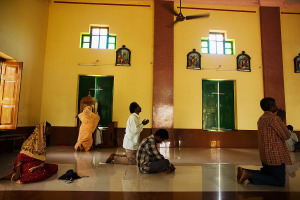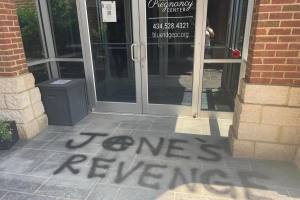US Couple Tells How Killer Tsunami Changed the Face of Bible Translation
John and Bonnie Nystrom, Wycliffe Linguists, Tell of 1998 Tsunami in Book 'Sleeping Coconuts'
Correction appended

Massive tsunami waves triggered by a magnitude-7.0 earthquake wiped out several villages, claimed thousands of lives and forever changed the way Bible translations previously had been done in Papua New Guinea.
The two Wycliffe Bible translators who helped pioneer the movement, and lost many of their friends in the storm, recently shared with The Christian Post how they believe God created a miracle out of tragedy.
John and Bonnie Nystrom, linguists for Wycliffe Bible Translators, recount in their recently published book, Sleeping Coconuts, how the devastating July 17, 1998, earthquake that shook the northern coast of Papua New Guinea, commonly referred to as PNG, claimed 843 lives from the Arop village where they had moved just 10 years prior to assist local pastors in translating the Bible into their own language. Some reports indicate 2,400 people living in the town of Aitape lost their lives in the earthquake and resulting tsunami, with the villages of Arop, Warapu and Nimas feeling the brunt of the waves. Another 9,500 people reportedly were left homeless.
"One out of every three people that we know was killed there, and some of the families that we know lost a lot of people. In fact, after the tsunami, our friend Pastor Peter Marokiki was the only one we knew; we know another family now – where the father mother and all the children survived. Every other family that we knew of, they lost at least some of their family members," Mr. Nystrom told The Christian Post.
"We were not there in the village at the time. If we had been, we would have been killed because our house and everything else in the village was completely washed away into the lagoon that was on the opposite side of where the village was located," added Mrs. Nystrom. "We were 300 miles away at the national translation center there in PNG and heard about it the following day."
The Nystroms, who joined Wycliffe in the early 80s and were sent to PNG to work with SIL International, said that high on the list of demands and needs of the Arop survivors was a desire for literacy. Villagers wanted to record their stories and tell of family members they had lost in the tsunami. Many local communities began requesting again, despite previous denials, to have the Bible in their own languages. But such a demand would likely take years to fulfill, as the existing translation model called for a single community or language to be worked with at a time.
"That's what we were doing, the typical thing that our organization always did, the two of us working in that one language and training the local people to do the Bible translation and then coaching them through the process," explained Mr. Nystrom.
But their thinking changed after the tsunami.
"We knew that if we said no to them, it could be decades, maybe generations, before somebody else would come and do a Bible translation for them," Mr. Nystrom added, noting that others felt the tragic climate made such a need particularly pertinent.
So the Nystroms said yes, "knowing that it was impossible."
"But when we said yes, we watched the Lord make it possible by providing more people to join our team, more Wycliffe members, and by the Arop translators that I had been working with taking leadership in the project," he said. "And then we watched Him provide facilities and equipment, everything that we need to make it possible – including an idea on how we might go about working in these multiple languages together."
The Nystroms and their partners developed the Aitape West Translation Project, "an experimental multi-language Bible translation and literacy project that includes at least 11 languages and dialects."
"And all of these pastors, 20-plus pastors, from 11 different languages, multiple different denominations, they all walk to this translation center each in one day and they come five times a year for a month at a time to work on the translations together. They work on the same Scripture, at the same place, at the same time," said Mr. Nystrom. He and his wife work remotely with the aid of technology from their home in Florida with the team in PNG, and make periodic trips to the island nation. They provide progress reports on the translation project on their website.
The translation project has resulted in the publication of Luke in nine languages and a soon-to-be published single volume of Luke and Acts, with another volume of 1 and 2 Timothy to follow.
One of the main objectives of the project, say the Nystroms, is "to develop a sustainable, repeatable Bible translation process that they can use to help other people in other languages later," which requires the local community to take ownership of the project.
"There are Christians there in the local community," explained Mrs. Nystrom. "The problem with not having the Scriptures is the people in their congregations, who are they going to believe?"
"Being able to test what's there for themselves through the Scriptures is really key ... but getting them accurate and clear is very important, getting them natural in the local community is very important. For us, to have these church leaders all working together, to have different denominations all cooperating together on a particular project; this is the only one that they do this on that we know of."
The Aitape West Translation Project also has become a form of seminary training and discipleship for locals deeply involved in the project, said Mr. Nystrom, who suggested that these 20-plus pastors are "learning more from the Bible than most people do at a Bible school or seminary" due to their daily inductive study of Scripture.
Another fruit of the translation project for the U.S. couple and their friends was being able to witness how God reveals His presence in the midst of tragedy and suffering.
And while the Nystroms are no longer in the field, the trends they see developing in Bible translation have them excited for the future.
"The Western and sometimes colonial idea that we need to go to the rest of the world and give them everything that they need and make it all happen for them, is no longer the way that the Church is thinking, and shouldn't be thinking that way," said Mrs. Nystrom. "Looking at the growing Church in other parts of the world and how they are taking up the responsibilities for the evangelism and discipleship of the people around them has been a really exciting trend to see as God has done that around the world."
She shared that in December while at Urbana, the InterVarsity-run conference that gathers thousands of young Christians to discuss missions, it was exciting to be able to share that when she and her husband joined Wycliffe in 1983, there were still 3,000 languages of the world that needed the Scripture. "But at the end of 2012, that number came down below 2,000 for the first time in history. It's fluctuating obviously as new translations are getting started all the time," she told CP.
"The exciting thing is, those who are in their 20s right now are the ones who may see the day when every language in the world has the Scriptures, or some portion of Scripture available to them in their own language. That's how fast the pace of Bible translation is picking up."
Correction: Tuesday, April 16, 2013:
In an April 12, 2013 article, "US Couple Tells How Killer Tsunami Changed the Face of Bible Translation," The Christian Post reported that the 1998 earthquake in Papua New Guinea wiped out thousands of villages and claimed hundreds of lives, when in fact several villages were destroyed and thousands of people killed. The Christian Post also reported that 800 people in the Arop village were killed. The actual number is 843. It was also reported that Aitape West Translation Project has published the Book of Luke in three languages, when in fact the group has published Luke in nine languages.




























